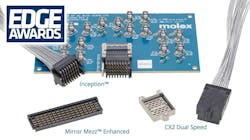High-Speed Chip-to-Chip Connectivity for the AI Era
Molex is staying a step ahead of the generative AI era with its new portfolio of backplanes, cable assemblies, board-to-board connectors, and near-ASIC connector-to-cable solutions rated for high speeds of up to 224 Gb/s.
Catering to technology giants and AI startups in need of high-speed chip-to-chip connectivity, the company has introduced Inception, its first genderless backplane system that can hit up to 224 Gb/s speeds based on PAM-4. Designed with a “cable-first” perspective, the cable assemblies have variable pitch densities and deliver optimal signal integrity with the ability to be plugged into a wide range of system architectures within and between server racks. It supports surface-mount technology (SMT) to address problems related to routing. This also enables easy placement since it removes complicated drilling and processing at the PCB interface.
Molex said Inception is designed to be placed as close as possible to the processor at the heart of a server or the networking chip in a switch, feeding the signals through cables to catapult them over the PCB, reducing signal degradation that can occur over long distances due to resistance present in the wiring of the PCB, electromagnetic interference (EMI), or other types of noise such as crosstalk and jitter. Molex said Inception unites a mechanically robust connector with cable tailored to fit into the tightest possible space. The length and gauge of the wires can be adjusted for optimal signal integrity.
High-density board-to-board connectors need to evolve for the AI era, too, Molex said. In many cases, a GPU or AI accelerator is soldered onto a server accelerator card that uses a mezzanine connector to communicate with the PCB housing the main CPU. Featuring a high density of connections, these high-speed connectors tether the GPU or other AI silicon directly to the PCB to address routing issues and enhance signal integrity.
Mirror Mezz Enhanced is Molex's new series of genderless mezzanine connectors that bridge the gaps between boards while slinging PAM-4 signals at speeds up to 224 Gb/s. Featuring a compact form factor, these high-density vertical-stacking connectors are studded with up to 270 differential pairs of pins, totaling more than 100 in every square inch. The BGA termination with short leads solves the problem of packing all these pins into a tiny package, which protrudes only 5 millimeters from the surface of the PCB, the company said.
The pitch between the contacts and “paddles” inside the connector varies to improve impedance. The paddle-to-contact bend direction alternates between rows to minimize crosstalk, which can degrade signal integrity. Molex said Mirror Mezz Enhanced can handle varying height requirements and PCB space constraints. To prevent anything from interfering with the high-speed signals, these connectors must also be mechanically robust—to withstand temperature fluctuations and other types of stress, including vibrations and shocks.
The high-density PCB connector is the latest offering in Molex’s Mirror Mezz family, one of the core building blocks of the Open Accelerator Module (OAM) industry standard developed by the Open Compute Project (OCP).
Another pillar of the company's 224G interconnect family is its new near-ASIC connector-to-cable system: the CX2 Dual-Speed. Molex said it features screw engagement after mating, an integrated strain-relief feature, a reliable mechanical wipe, and a fully protected “thumb-proof” mating interface to ensure long-term reliability. High-performance cabling and robust shielding give it superior isolation against signal degradation.
Shooting PAM-4 signals out of 224G SerDes and sending them over the PCB can cause them to deteriorate unless high-quality materials are used to limit signal losses and noise. To prevent the distortion of these high-speed signals, it is becoming standard practice to place near-ASIC connectors as close to a processor, switch, or other chip as possible and then catapult the signals over the lossy PCB to the front of the server or switch using Twinax cables. In this case, the CX2 connector is linked to the Inception cable assembly to run up to 224 Gb/s.
Molex said the 224G portfolio also stands out due to its innovative development approach. By working closely with the larger ecosystem further ahead of time and using predictive analytics and simulation testing, Molex said it proactively identified and fixed potential performance bottlenecks and design challenges, ranging from signal integrity and EMI reduction to more efficient heat removal. The result is a robust solution that ensures a high degree of electrical, mechanical, physical, and signal integrity.

